What's New
Displaying results 4621 - 4630 of 4914
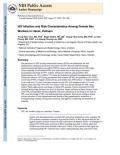
Resource | Publications,
The prevalence of HIV/sexually transmitted diseases (STDs) was determined, the risk characteristics examined, and factors associated with HIV infection identified among noninstitutionalized female sex workers (FSWs), using a cross-sectional survey with two-stage cluster sampling.

Resource | Publications,
Estimation and projection of HIV/AIDS plays an increasingly important role in the planning and evaluation of national HIV/AIDS programs. National programs need to know where the epidemic is currently concentrated to assist in directing their prevention efforts. They need estimates of future burden and impacts to anticipate prevention and care needs and to adequately plan for impact mitigation. And, increasingly, international bilateral and multilateral aid agencies are insisting countries show that their programs are making a difference as a condition of continued funding.
In concentrated epidemics, such as that in Vietnam, the estimation of HIV is not a straightforward process. While HIV surveillance data has been routinely collected since 1994 in Vietnam, the translation of surveillance results into estimates requires a careful review of what populations surveillance data represents and critical analysis of existing data from numerous other sources.
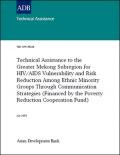
Resource | Publications,
This technical assistance (TA) aims to reduce the vulnerability to, and risk of, HIV/AIDS transmission among ethnic minority groups through communication strategies. The TA focuses on ethnic minorities that live in cross-border areas in the GMS. An Asian Development Bank (ADB) regional TA (RETA), begun in 2002 and completed in December 2004, dealt with HIV/AIDS in GMS areas. The proposed TA will build on the achievements of RETA 6083 by (i) scaling-up to address the increased risk of HIV/AIDS due to human trafficking and drug abuse; and (ii) scaling-out to include new ethnic groups prioritized by government partners.5 The TA will build on ADB’s past work in strengthening the human capital of ethnic minorities, including addressing their vulnerability to HIV/AIDS, and will coordinate with ongoing TAs on human trafficking and drug abuse in reducing structural vulnerabilities, for example citizenship and land tenure, among ethnic minorities in cross-border areas of the GMS.

Resource | Publications,
In Cambodia, behavioral surveillance surveys (BSS) have been conducted regularly since 1997. These surveys have gathered data on sexual behaviors among brothel-based sex workers, women working for beer companies, police, military, and moto-taxi drivers in the same five provinces using a consistent methodology. For this year round (BSS VI), five new provinces were added to the sample.
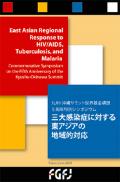
Resource | Publications,
This report contains the proceedings of a June 30, 2005, conference on the "East Asian Regional Response to HIV/AIDS, Tuberculosis, and Malaria," organized to commemorate the fifth anniversary of the Kyushu-Okinawa G8 Summit.
It is widely recognized that HIV/AIDS and other infectious diseases are among the world’s most urgent human security challenges, threatening the survival and livelihood of individuals and communities around the globe, particularly in developing countries. As many speakers emphasized, these diseases are increasingly regarded as threats to human security, and as a result they closely intersect with other threats such as poverty, hunger, in- equality, and violence, requiring a multifaceted and multisectoral response. In her talk, Dr. Kamarulzaman added several other socioeconomic factors that affect the region’s response to the spread of HIV/AIDS, such as vary- ing levels of literacy, rural to urban migration, and trafficking of women and children.
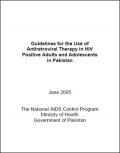
Resource | Publications,
Successful treatment of HIV/AIDS depends on strict adherence by HIV positive patients in taking their medications as instructed and for health care providers to recommend antiretroviral treatment (ART) based on rigorous scientific evidence. The devastating consequences of incorrect or partial HIV treatment are premature death, increased morbidity, development of drug resistant HIV strains, and lack of further treatment options.
The main purpose of these guidelines is to assist health care providers in determining the optimal ART regimen for their HIV positive patients and to provide recommendations for standardized quality of care. We hope that compliance with the guidelines will reduce the risk of treatment failures, prevent ART resistance and in the long term enable Pakistan to successfully contain the HIV/AIDS epidemic.
It is crucial to for health care providers and patients to understand that treatment and care of HIV is an evolving science. While these guidelines contain the latest recommended ART practices, they are a living document. The National AIDS Control Program would like to emphasize that these guidelines will be regularly revised and updated to incorporate new information and best practices.

Resource | Publications,
Since late 2003, when WHO and UNAIDS launched a strategy for ensuring treatment for 3 million people living with HIV/AIDS in low- and middle-income countries by the end of 2005 (the "3 by 5" target), coverage of antiretroviral therapy (ART) in these countries has more than doubled – increasing from 400 000 to approximately 1 million people receiving treatment at the end of June 2005. To date, 14 of these countries are providing ART to at least 50 per cent of those who need it, consistent with the "3 by 5" target.
This interim report on global efforts to increase access to ART focuses primarily on understanding the reasons for the successes and failures of scaling up HIV/AIDS interventions in different settings. The report also makes recommendations concerning the approaches needed to overcome major bottlenecks, as well as the need for sustainable financing mechanisms and greater harmonization of effort by technical and financing partners at country level. A comprehensive report and country-specific analysis of access efforts and obstacles that remain will be released at the end of 2005.

Resource | Publications,
With national estimated prevalence of between 0.6% and 2.2%, Myanmar is experiencing a generalized epidemic, considered one of the most serious in Asia. The Ministry of Health estimates that 338,911 adults aged 15–49 years old were living with HIV/AIDS in September 2004, of which 96,834 (28.6%) were women, indicating a total adult prevalence rate of 1.3%. HIV infection rates vary across the country, with several regions showing considerable increases in prevalence rates among less vulnerable populations. According to the Ministry of Health, in 2003, 12 of 29 sentinel sites for pregnant women showed a prevalence of HIV infection exceeding 2%. At Pyay and Hpa-an, prevalence rates among pregnant women were as high as 5% and 7.5% respectively.

Resource | Publications,
The countries of Asia and the Pacific stand at a crossroads, facing two diverging routes to the future. One route is “business as usual”. Though the easiest and cheapest route to take at the beginning, it ends up in rising levels of HIV infection and a toll far higher than the estimated 500 000 AIDS-related deaths that occurred in the region during 2004. The other route is one of determined prevention and care initiatives. Harder and more expensive at the beginning, it ends up stopping the epidemic in its tracks, and minimizing both its human and economic costs.
This report summarizes the AIDS challenge in Asian and Pacific countries. Using the best available evidence, it discusses the reasons why critical services currently reach only a fraction of those in need. It also outlines the action needed that will allow the region to seize this key moment of opportunity.
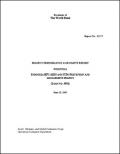
Resource | Publications,
The HIV/AIDS and STDs Prevention and Management Project (HSPMP) aimed to use intensive pilot efforts to achieve two objectives: (a) develop HIV/AIDS and STD institutional mechanisms at the national and provincial levels; and (b) develop interventions capable of reducing transmission of HIV and STDs. The total Project cost of $35.2 million was to be financed with an IBRD loan of $24.8 million and government counterpart funding for the remaining $10.4 million.
The HSPMP represented an effort to address the world-wide AIDS pandemic in Indonesia in the pre-epidemic stage of the disease. Prior to project preparation, in the early-mid 1990s, attention of policy makers in Indonesia and the Bank was gained for early intervention with commercial sex workers through epidemiological projections showing that, with no change in preventive efforts, Indonesia would have 500,000 sexually transmitted HIV infections within four years. These scenarios turned out to be quite inaccurate. Sexually transmitted HIV remains even today at a low level in Indonesia, while HIV transmission associated with drug use has grown rapidly.





